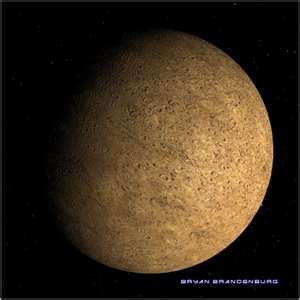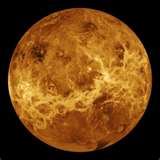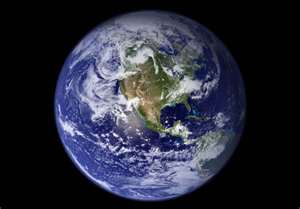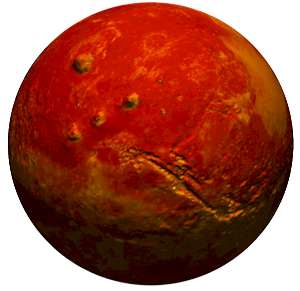Inner Planets Of Solar System Quiz! Trivia
(85).jpg)
Can you pass this Inner Planets of Solar System Trivia? Our solar system is made up of a number of planets that go round one sun. Mercury is the closes to the sun and the earth is the only planet that can support life and plant growth so far. Expeditions made outside the earth found out unlike the earth most of the planets around us have more than one moon. Take the quiz and learn more facts on the planets in our solar system.
- 1.
What is the biggest inner planet?
- A.
Mercury
- B.
Venus
- C.
Earth
- D.
Mars
Correct Answer
C. EarthExplanation
Earth is the correct answer because it is the largest inner planet in our solar system. While Mercury is the smallest inner planet, Venus is slightly smaller than Earth, and Mars is larger than Mercury and Venus but still smaller than Earth. Therefore, Earth is the biggest inner planet among the given options.Rate this question:
-
- 2.
How many moon(s) do(es) Mars have?
- A.
1
- B.
2
- C.
3
- D.
4
- E.
5
- F.
6
- G.
7
- H.
8
- I.
9
- J.
10
- K.
11
Correct Answer
B. 2Explanation
Mars has two moons, Phobos and DeimosRate this question:
-
- 3.
The inner planets and outer planets are divided by a boundary of debris known as the what?
- A.
Kiper Belt
- B.
Asteroid Belt
- C.
Comet Debris
- D.
Solar Flares
- E.
The Big Bang
Correct Answer
B. Asteroid BeltExplanation
The correct answer is Asteroid Belt. The inner planets and outer planets are separated by a region in our solar system called the Asteroid Belt. This belt is located between the orbits of Mars and Jupiter and is composed of numerous small rocky objects called asteroids. These asteroids are remnants from the early formation of the solar system and are believed to be the building blocks of planets that never fully formed. The Asteroid Belt acts as a barrier between the inner and outer planets, preventing them from colliding with each other.Rate this question:
-
- 4.
Which of the inner planets is considered Earth's Twin?
- A.
Mercury
- B.
Venus
- C.
Mars
- D.
Jupiter
- E.
Pluto
Correct Answer
B. VenusExplanation
Venus is considered Earth's twin because it is the most similar planet to Earth in terms of size, composition, and distance from the Sun. Both Venus and Earth are rocky planets with similar densities and gravity. They also have similar atmospheres, although Venus has a much thicker and hotter atmosphere, making it inhospitable for life. Venus is often referred to as Earth's twin due to these similarities, making it the correct answer to the question.Rate this question:
-
- 5.
What is the primary difference between the inner planets and outer planets?
- A.
The inner planets are furthest away from the sun
- B.
The inner planets are rocky planets
- C.
The inner planets are gas giants
- D.
The inner planets all have breathable atmospheres for Human Beings
Correct Answer
B. The inner planets are rocky planetsExplanation
The primary difference between the inner planets and outer planets is that the inner planets are rocky planets. This means that they have solid surfaces made up of rocks and metals. In contrast, the outer planets, also known as gas giants, are primarily composed of gases such as hydrogen and helium.Rate this question:
-
- 6.
The Sun is a planet.
- A.
True
- B.
False
Correct Answer
B. FalseExplanation
The statement that "The Sun is a planet" is false. The Sun is not a planet, but rather a star. Planets are celestial bodies that orbit around stars, and the Sun is the star at the center of our solar system. It is much larger and more massive than any planet, and it emits light and heat due to nuclear fusion reactions happening in its core.Rate this question:
-
- 7.
What are the 2 names of Mars' Moons?
- A.
The Moons
- B.
Mercury and Venus
- C.
Phobos and Deimos
- D.
Tom and Jerry
Correct Answer
C. Phobos and DeimosExplanation
Phobos and Deimos are the two names of Mars' moons. These moons were discovered in 1877 by American astronomer Asaph Hall. Phobos, the larger moon, and Deimos, the smaller moon, are both thought to be captured asteroids due to their irregular shapes and composition. They orbit close to Mars and are believed to have formed from the debris of a large impact on the planet. Phobos and Deimos play a significant role in the study of Mars' gravitational field and the planet's geological history.Rate this question:
-
- 8.
What is the galaxy that we live in called?
- A.
The Milky Way
- B.
Three Muskateers
- C.
Snickers
- D.
Butterfinger
Correct Answer
A. The Milky WayExplanation
The correct answer is The Milky Way. The Milky Way is the galaxy that we live in. It is a barred spiral galaxy that contains our solar system, along with billions of other stars and planets. The name "Milky Way" comes from its appearance as a hazy band of light in the night sky, which is caused by the combined light of countless stars.Rate this question:
-
- 9.
What planet is the 3rd planet from the sun?
- A.
Jupiter
- B.
Earth
- C.
Mars
- D.
Uranus
Correct Answer
B. EarthExplanation
Earth is the correct answer because it is the third planet from the sun. It is located between Venus and Mars in our solar system. Earth is known for its unique characteristics, such as being the only planet with liquid water, an atmosphere that supports life, and its moderate climate.Rate this question:
-
- 10.
The Sun is a star.
- A.
True
- B.
False
Correct Answer
A. TrueExplanation
The statement "The Sun is a star" is true because the Sun is indeed a star. It is a medium-sized star located at the center of our solar system. It is primarily composed of hydrogen and helium gases and generates energy through nuclear fusion. The Sun's immense gravitational pull keeps the planets in orbit around it. It emits light and heat, making it a star.Rate this question:
-
- 11.
The atmosphere has low pressure and is mostly carbon dioxide.
- A.
Mars
- B.
Venus
- C.
Mercury
- D.
Earth
Correct Answer
A. MarsExplanation
Mars has a thin atmosphere with low pressure, consisting mostly of carbon dioxide. This is in contrast to Venus, which has a dense atmosphere with high pressure and a large amount of carbon dioxide. Mercury, on the other hand, has a very thin atmosphere, while Earth has a much denser atmosphere with a mix of gases including nitrogen and oxygen. Therefore, based on the given information, Mars is the most suitable answer.Rate this question:
-
- 12.
What is this planet?
Correct Answer
MercuryExplanation
Mercury is the correct answer because it is the name of a planet. It is the closest planet to the sun in our solar system and is also the smallest planet.Rate this question:
- 13.
What is this planet?
Correct Answer
venusExplanation
Venus is the correct answer because it is a planet in our solar system. It is the second planet from the Sun and is often referred to as Earth's "sister planet" due to its similar size and composition. Venus is known for its thick atmosphere, which traps heat and creates a runaway greenhouse effect, making it the hottest planet in our solar system.Rate this question:
- 14.
Which planet is this?
Correct Answer
EarthExplanation
The given question asks for the name of the planet shown in the image or described in the context. The answer "Earth" directly corresponds to the question, indicating that the planet being referred to is indeed Earth.Rate this question:
- 15.
Which planet is this?
Correct Answer
MarsExplanation
The given question asks for the name of the planet, and the answer provided is "Mars." Therefore, the correct answer to the question is Mars.Rate this question:
- 16.
Similar to each other in size density and internal structure.
- A.
Venus
- B.
Earth
- C.
Mars
- D.
Mercury
Correct Answer(s)
A. Venus
B. EarthExplanation
Venus and Earth are similar to each other in size, density, and internal structure. Both planets are rocky terrestrial planets with similar sizes and densities. They also have similar internal structures, consisting of a solid inner core, a molten outer core, a mantle, and a crust. This similarity in size, density, and internal structure suggests that Venus and Earth may have formed under similar conditions and processes.Rate this question:
-
- 17.
Has a rocky surface.
- A.
Mercury
- B.
Earth
- C.
Venus
- D.
Mars
Correct Answer(s)
A. Mercury
B. Earth
C. Venus
D. MarsExplanation
The correct answer is the order of the planets in our solar system based on their proximity to the sun. Starting from the closest to the sun, the order is Mercury, Venus, Earth, and Mars. This order is determined by their respective distances from the sun and their positions in the solar system.Rate this question:
-
- 18.
The trapping of heat by the atmosphere.
- A.
Greenhouse effect
- B.
Ring
- C.
Gas giants
- D.
Catch 22
Correct Answer
A. Greenhouse effectExplanation
The greenhouse effect refers to the trapping of heat by the atmosphere. This occurs when certain gases, such as carbon dioxide and methane, absorb and re-emit infrared radiation, preventing it from escaping into space. As a result, the Earth's surface and lower atmosphere are warmed. This phenomenon is similar to how a greenhouse traps heat, hence the term "greenhouse effect." The greenhouse effect is essential for maintaining a habitable temperature on Earth, but human activities, such as burning fossil fuels, have increased the concentration of greenhouse gases, leading to global warming and climate change.Rate this question:
-
- 19.
Spinning motion east to the west opposite of other planets.
- A.
Retrograde rotation
- B.
Ring
- C.
Greenhouse effect
- D.
Backspacing
Correct Answer
A. Retrograde rotationExplanation
Retrograde rotation refers to the spinning motion of a celestial body in the opposite direction to the majority of other bodies in its system. In the context of the given question, the statement "Spinning motion east to the west opposite of other planets" suggests that the celestial body in question rotates in the opposite direction to the rotation of most other planets. Therefore, retrograde rotation is the correct answer.Rate this question:
-
- 20.
The first four planets from the sun and they have rocky surfaces.
- A.
Terrestrial planets
- B.
Ring
- C.
Retrograde rotation
- D.
Dirt type planets
Correct Answer
A. Terrestrial planetsExplanation
The correct answer is "terrestrial planets". Terrestrial planets are the first four planets from the sun, namely Mercury, Venus, Earth, and Mars. These planets are called terrestrial because they have solid, rocky surfaces as opposed to gas giants like Jupiter and Saturn. They are also often referred to as inner planets.Rate this question:
-
- 21.
Has a tilted axis that causes seasons.
- A.
Earth
- B.
Mars
- C.
Mercury
- D.
Venus
Correct Answer(s)
A. Earth
B. MarsExplanation
Earth and Mars have a tilted axis, which means that their axis is not perpendicular to their orbital plane around the sun. This tilt causes the two planets to experience seasons. As they orbit the sun, different parts of the planets receive different amounts of sunlight, leading to variations in temperature and weather patterns. Mercury and Venus, on the other hand, do not have a significant tilt in their axis, so they do not experience distinct seasons like Earth and Mars.Rate this question:
-
- 22.
The atmosphere is so heavy and thick that it would crush a human.
- A.
Venus
- B.
Earth
- C.
Mars
- D.
Mercury
Correct Answer
A. VenusExplanation
Venus has an extremely dense atmosphere composed mainly of carbon dioxide, with clouds of sulfuric acid. The pressure at the surface of Venus is about 92 times that of Earth's, equivalent to the pressure experienced 900 meters underwater on Earth. This immense atmospheric pressure would make it impossible for a human to survive on Venus, as it would exert a crushing force on the body.Rate this question:
-
- 23.
Has almost no atmosphere.
- A.
Mercury
- B.
Venus
- C.
Earth
- D.
Mars
Correct Answer
A. MercuryExplanation
Mercury has almost no atmosphere because its low gravity cannot hold onto gases. The planet is close to the Sun, which causes its surface to become extremely hot, leading to the escape of any gas molecules that may have been present. Additionally, Mercury lacks a strong magnetic field to protect its atmosphere from solar winds, further contributing to its lack of significant atmosphere.Rate this question:
-
- 24.
Has at least one moon.
- A.
Earth
- B.
Mars
- C.
Mercury
- D.
Venus
Correct Answer(s)
A. Earth
B. MarsExplanation
Earth and Mars are the correct answers because both of these planets have at least one moon. Earth has one moon called the Moon, while Mars has two moons named Phobos and Deimos. On the other hand, Mercury and Venus do not have any moons.Rate this question:
-
- 25.
Called the ''red planets'' because of the color of the dust.
- A.
Mars
- B.
Venus
- C.
Earth
- D.
Mercury
Correct Answer
A. MarsExplanation
Mars is called the "red planet" because of the color of the dust. This is due to the presence of iron oxide, also known as rust, on its surface. The iron oxide gives Mars its distinct reddish appearance, making it easily distinguishable from other planets in the solar system.Rate this question:
-
- 26.
Rotates in the opposite direction from most other planets and moons.
- A.
Venus
- B.
Mars
- C.
Earth
- D.
Mercury
Correct Answer
A. VenusExplanation
Venus rotates in the opposite direction from most other planets and moons. While the majority of celestial bodies in our solar system rotate counterclockwise when viewed from above the North Pole, Venus rotates clockwise. This unique retrograde rotation is believed to have been caused by a massive collision with another celestial object in the past, which reversed its original rotation direction. As a result, Venus stands out among the other planets and moons in our solar system.Rate this question:
-
- 27.
70% covered with water.
- A.
Mercury
- B.
Mars
- C.
Earth
- D.
Venus
Correct Answer
C. EarthExplanation
Earth is the correct answer because it is the only planet in our solar system that is known to be approximately 70% covered with water. Mercury, Mars, and Venus do not have significant amounts of liquid water on their surfaces. Earth's abundance of water is a crucial factor for supporting life as we know it.Rate this question:
-
- 28.
What is the order of the inner planets as you leave the sun?
- A.
Mars,Earth, Venus, Mercury
- B.
Mercury, Venus, Mars, Earth
- C.
Mercury, Earth, Venus, Mars
- D.
Mercury, Venus, Earth, Mars
Correct Answer
D. Mercury, Venus, Earth, MarsExplanation
The order of the inner planets as you leave the sun is Mercury, Venus, Earth, Mars. This is because Mercury is the closest planet to the sun, followed by Venus, Earth, and then Mars.Rate this question:
-
Quiz Review Timeline +
Our quizzes are rigorously reviewed, monitored and continuously updated by our expert board to maintain accuracy, relevance, and timeliness.
-
Current Version
-
Mar 22, 2023Quiz Edited by
ProProfs Editorial Team -
Jul 03, 2012Quiz Created by
Yourpawdoc
 Back to top
Back to top






